Orientation – Part One (12.09.2005 – 18.09.2005)
We have been participating in our Orientation program and German class for the past two weeks, so I am sorry that I have not been able to post any blog entries for a while. Our orientation program was not a school orientation (like the one at NC State), but rather a cultural orientation program. This meant that we went on different trips in Vienna and Austria to learn more about the area that we are living in for the semester. It was a lot of fun, and I learned quite a bit about life in Austria. We also had our German class for the past two weeks, so I have learned to speak enough German to get by with. I also signed up to have a German Language buddy, so she will help me with my German, and I will help her with her English. I am starting to enjoy living in Vienna even more, now that I know more about how and why the city has evolved to its current state.
And now, on to the travel portion of the blog post…
Schloss Belvedere and the “New Austria” Exhibition
On Thursday (15.09.2005), we attended a lecture on the Austrian Political System at school. It was a very interesting lecture, and I was glad we were able to attend, since elections will be held in Vienna this fall. An interesting fact that I learned is that there are over 600 political parties in Austria (and no, the 600 is not a typo). Apparently, it is very easy to form a political party in Austria (you only need one person to do it), so whenever someone has an idea or reform that they want to promote, they just form a new political party. However, out of the 600, only 4-5 parties are of national political relevance – the rest are related to regional or city politics.
After the lecture, we took the tram through town to Schloss Belvedere. Schloss Belvedere is a palace that now houses the Osterreichische Galerie (Austrian Gallery) and it hosts different exhibitions throughout the year. We went to the “New Austria” exhibition, which shows the history of Austria from 1914 (when the Habsburg dynasty ended) up to present day Austria. This exhibition is being held because Austria is currently celebrating their 50th anniversary as the Republic of Austria. The State Treaty of Austria was signed on 15.05.1955, and the last occupying forces exited the country on 25.10.1955. October 26th is National Austria Day, since it was the first day that the country was unoccupied. Since this year is the 50th anniversary of the State Treaty, there are big celebrations happening all over the country and I can’t even imagine what the celebrations on National Austria Day will be like. The New Austria exhibition was very interesting, and I think I will be going back to have another look at it (you can never get the full experience when you are being herded like cattle on a guided tour).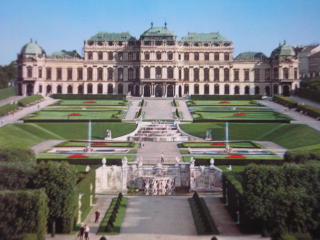
Vienna City Tour
On Friday (16.09.2005), we went on a bus tour of the city of Vienna. It was very interesting, but I would much prefer to get out and walk around at places, as opposed to having a fleeting glance of them as we drive by. We were able to walk around the Hundertwasser-KrawinaHaus, which is an apartment building that Friedensreich Hundertwasser built in the early 1980s. This building is very unique, because Hundertwasser coated the outside with different colored plasters (for each apartment) as well as tiles and bricks.
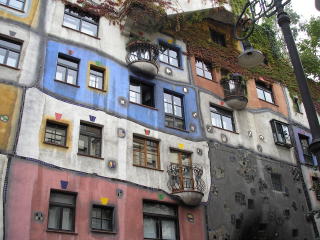 Seeing the Hundertwasser Haus was a great experience for me, because Hundertwasser also designed the power plant that is located near our school. The Fernwarme Wien is a power plant that burns the city’s trash to make electricity. It definitely looks different from our power plants back home, doesn’t it?
Seeing the Hundertwasser Haus was a great experience for me, because Hundertwasser also designed the power plant that is located near our school. The Fernwarme Wien is a power plant that burns the city’s trash to make electricity. It definitely looks different from our power plants back home, doesn’t it?
 Something that I have learned in Vienna is that Austria does not use any nuclear power. In the 1970s, the president of Austria commissioned a nuclear power plant to be built in Austria. After it was completed, the Austrian people voted on a referendum on whether to produce nuclear power or not. The president assumed that the people would vote ‘yes’, since the nuclear power plant had already been built. Instead, he was greatly surprised when the Austrian people overwhelmingly voted ‘no’ to the production of nuclear power. Therefore, no nuclear power is produced in Austria.
Something that I have learned in Vienna is that Austria does not use any nuclear power. In the 1970s, the president of Austria commissioned a nuclear power plant to be built in Austria. After it was completed, the Austrian people voted on a referendum on whether to produce nuclear power or not. The president assumed that the people would vote ‘yes’, since the nuclear power plant had already been built. Instead, he was greatly surprised when the Austrian people overwhelmingly voted ‘no’ to the production of nuclear power. Therefore, no nuclear power is produced in Austria.
Graz – the second largest city in Austria
On Saturday (09.17.2005), we took a bus trip to the city of Graz. The weather was cold and rainy that day, but we still had a good trip. We went on a two-hour walking tour of the city, which was very nice. Graz is relatively compact, so we were able to see quite a bit of the city in those two hours. Below, you can see a picture of my friend, Roser, and I dancing as a street musician plays the violin. As you can see, we were having fun despite the weather.
 While we were on the Graz city tour, our tour guide pointed out the first apartment building in Graz. Apparently, a wealthy banker decided to build an enormous house on the center square of the city. When the house was completed, the banker had run out of money and could not pay all of his debts. So, he gave rooms in the house to the people that he owed money to. And that’s how his house became the first apartment building in Graz.
While we were on the Graz city tour, our tour guide pointed out the first apartment building in Graz. Apparently, a wealthy banker decided to build an enormous house on the center square of the city. When the house was completed, the banker had run out of money and could not pay all of his debts. So, he gave rooms in the house to the people that he owed money to. And that’s how his house became the first apartment building in Graz.
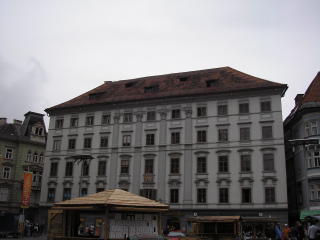
After we left Graz, we went to the Osterreichisches Freilichtmuseum Stubing bei Graz (Austrian Open-Air Museum at Stubing by Graz). It is a museum that has rural homesteads from all nine provinces in Austria, and some of the buildings date back several hundred years. Our tour guide at the museum said that all of the buildings are original, not reproductions. He said that when the museum curators find a building to add to the collection, they go to the original site and take pictures and draw up plans of the building. Then, they take it apart piece by piece, and number each one as they go. When they get all of the pieces moved back to the museum, they put them back together to reassemble to building – kind of like a gigantic 3-D jigsaw puzzle. The curators of the museum also maintain vegetable and flower gardens and keep farm animals at the museum to make everything as authentic as possible. If you would like to see more about the Osterreicheisches Freilichtmuseum, you can go to www.freilichtmuseum.at.
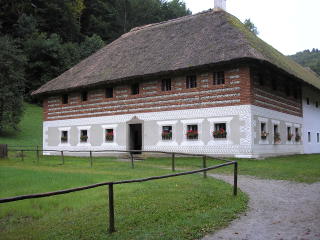
Fest der Freiheit
On Sunday (18.09.2005), Lara and I went walking throughout Vienna with a couple of friends. While we were out walking, we came up a huge festival in front of the Rathaus (City Hall). It was a celebration of Austria’s 50th anniversary of freedom, and it was very interesting. Bands were playing American music (John Phillip Sousa’s Stars and Stripes Forever) and there were American cars from the 1950s. We even saw some people dressed in poodle skirts! As a part of the celebration, the city mayors from London, Moscow, Paris, and Washington, D.C. came up on stage and spoke about what a great country Austria is. It was a unique experience to see so much American culture in the center of Vienna, and it felt a little bit like the Fourth of July!
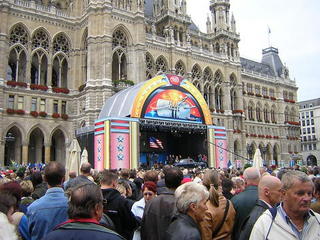
Well, that is the end of the first part of Orientation. I will be posting the second part very soon!
~Andria

0 Comments:
Post a Comment
<< Home